I'm trying to select a random 10% sampling from a small table. I thought I'd just use the RAND() function and select those rows where the random number is less than 0.10:
SELECT * FROM SomeTable
WHERE SomeColumn='SomeCondition' AND
RAND() < 0.10
But I soon discovered that RAND() always returns the same number! Reminds me of this xkcd cartoon.

OK, no problem, the RAND function takes a seed value. I will be running this query periodically, and I want it to give different results if I run it on a different day, so I seed it with a combination of the date and a unique row ID:
SELECT * FROM SomeTable
WHERE SomeColumn='SomeCondition' AND
RAND(CAST(GETDATE) AS INTEGER) + RowID) < 0.10
I still don't get any results! When I show the random numbers returned by RAND, I discover that they're all within a narrow range. It appears that getting a random number from RAND requires you to use a random seed. If I had a random seed in the first place, I wouldn't need a random number!
I've seen the previous discussions related to this problem:
SQL Server Random Sort
How to request a random row in SQL?
They don't help me. TABLESAMPLE works at the page level, which is great for a big table but not for a small one, and it looks like it applies prior to the WHERE clause. TOP with NEWID doesn't work because I don't know ahead of time how many rows I want.
Anybody have a solution, or at least a hint?
Edit: Thanks to AlexCuse for a solution which works for my particular case. Now to the larger question, how to make RAND behave?